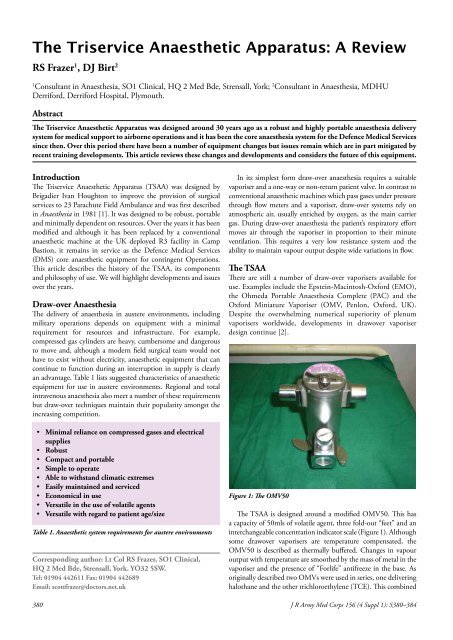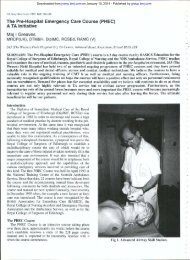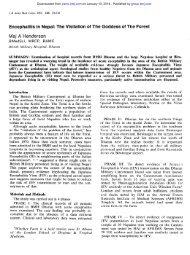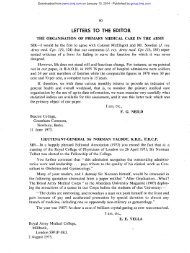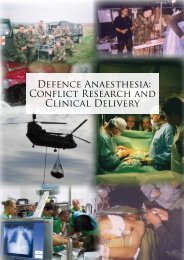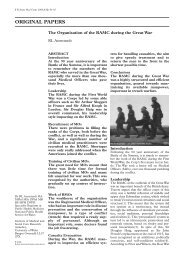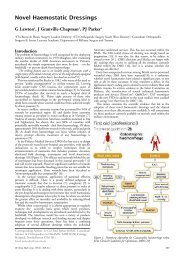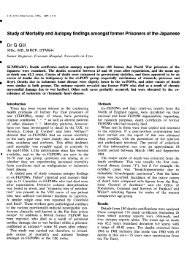The Triservice Anaesthetic Apparatus: A Review - Journal of the ...
The Triservice Anaesthetic Apparatus: A Review - Journal of the ...
The Triservice Anaesthetic Apparatus: A Review - Journal of the ...
You also want an ePaper? Increase the reach of your titles
YUMPU automatically turns print PDFs into web optimized ePapers that Google loves.
<strong>The</strong> <strong>Triservice</strong> <strong>Anaes<strong>the</strong>tic</strong> <strong>Apparatus</strong>: A <strong>Review</strong><br />
RS Frazer 1 , DJ Birt 2<br />
1 Consultant in Anaes<strong>the</strong>sia, SO1 Clinical, HQ 2 Med Bde, Strensall, York; 2 Consultant in Anaes<strong>the</strong>sia, MDHU<br />
Derriford, Derriford Hospital, Plymouth.<br />
Abstract<br />
<strong>The</strong> <strong>Triservice</strong> <strong>Anaes<strong>the</strong>tic</strong> <strong>Apparatus</strong> was designed around 30 years ago as a robust and highly portable anaes<strong>the</strong>sia delivery<br />
system for medical support to airborne operations and it has been <strong>the</strong> core anaes<strong>the</strong>sia system for <strong>the</strong> Defence Medical Services<br />
since <strong>the</strong>n. Over this period <strong>the</strong>re have been a number <strong>of</strong> equipment changes but issues remain which are in part mitigated by<br />
recent training developments. This article reviews <strong>the</strong>se changes and developments and considers <strong>the</strong> future <strong>of</strong> this equipment.<br />
Introduction<br />
<strong>The</strong> <strong>Triservice</strong> <strong>Anaes<strong>the</strong>tic</strong> <strong>Apparatus</strong> (TSAA) was designed by<br />
Brigadier Ivan Houghton to improve <strong>the</strong> provision <strong>of</strong> surgical<br />
services to 23 Parachute Field Ambulance and was first described<br />
in Anaes<strong>the</strong>sia in 1981 [1]. It was designed to be robust, portable<br />
and minimally dependent on resources. Over <strong>the</strong> years it has been<br />
modified and although it has been replaced by a conventional<br />
anaes<strong>the</strong>tic machine at <strong>the</strong> UK deployed R3 facility in Camp<br />
Bastion, it remains in service as <strong>the</strong> Defence Medical Services<br />
(DMS) core anaes<strong>the</strong>tic equipment for contingent Operations.<br />
This article describes <strong>the</strong> history <strong>of</strong> <strong>the</strong> TSAA, its components<br />
and philosophy <strong>of</strong> use. We will highlight developments and issues<br />
over <strong>the</strong> years.<br />
Draw-over Anaes<strong>the</strong>sia<br />
<strong>The</strong> delivery <strong>of</strong> anaes<strong>the</strong>sia in austere environments, including<br />
military operations depends on equipment with a minimal<br />
requirement for resources and infrastructure. For example,<br />
compressed gas cylinders are heavy, cumbersome and dangerous<br />
to move and, although a modern field surgical team would not<br />
have to exist without electricity, anaes<strong>the</strong>tic equipment that can<br />
continue to function during an interruption in supply is clearly<br />
an advantage. Table 1 lists suggested characteristics <strong>of</strong> anaes<strong>the</strong>tic<br />
equipment for use in austere environments. Regional and total<br />
intravenous anaes<strong>the</strong>sia also meet a number <strong>of</strong> <strong>the</strong>se requirements<br />
but draw-over techniques maintain <strong>the</strong>ir popularity amongst <strong>the</strong><br />
increasing competition.<br />
• Minimal reliance on compressed gases and electrical<br />
supplies<br />
• Robust<br />
• Compact and portable<br />
• Simple to operate<br />
• Able to withstand climatic extremes<br />
• Easily maintained and serviced<br />
• Economical in use<br />
• Versatile in <strong>the</strong> use <strong>of</strong> volatile agents<br />
• Versatile with regard to patient age/size<br />
Table 1. <strong>Anaes<strong>the</strong>tic</strong> system requirements for austere environments<br />
Corresponding author: Lt Col RS Frazer, SO1 Clinical,<br />
HQ 2 Med Bde, Strensall, York. YO32 5SW.<br />
Tel: 01904 442611 Fax: 01904 442689<br />
Email: scottfrazer@doctors.net.uk<br />
In its simplest form draw-over anaes<strong>the</strong>sia requires a suitable<br />
vaporiser and a one-way or non-return patient valve. In contrast to<br />
conventional anaes<strong>the</strong>tic machines which pass gases under pressure<br />
through flow meters and a vaporiser, draw-over systems rely on<br />
atmospheric air, usually enriched by oxygen, as <strong>the</strong> main carrier<br />
gas. During draw-over anaes<strong>the</strong>sia <strong>the</strong> patient’s respiratory effort<br />
moves air through <strong>the</strong> vaporiser in proportion to <strong>the</strong>ir minute<br />
ventilation. This requires a very low resistance system and <strong>the</strong><br />
ability to maintain vapour output despite wide variations in flow.<br />
<strong>The</strong> TSAA<br />
<strong>The</strong>re are still a number <strong>of</strong> draw-over vaporisers available for<br />
use. Examples include <strong>the</strong> Epstein-Macintosh-Oxford (EMO),<br />
<strong>the</strong> Ohmeda Portable Anaes<strong>the</strong>sia Complete (PAC) and <strong>the</strong><br />
Oxford Miniature Vaporiser (OMV, Penlon, Oxford, UK).<br />
Despite <strong>the</strong> overwhelming numerical superiority <strong>of</strong> plenum<br />
vaporisers worldwide, developments in drawover vaporiser<br />
design continue [2].<br />
Figure 1: <strong>The</strong> OMV50<br />
<strong>The</strong> TSAA is designed around a modified OMV50. This has<br />
a capacity <strong>of</strong> 50mls <strong>of</strong> volatile agent, three fold-out “feet” and an<br />
interchangeable concentration indicator scale (Figure 1). Although<br />
some drawover vaporisers are temperature compensated, <strong>the</strong><br />
OMV50 is described as <strong>the</strong>rmally buffered. Changes in vapour<br />
output with temperature are smoo<strong>the</strong>d by <strong>the</strong> mass <strong>of</strong> metal in <strong>the</strong><br />
vaporiser and <strong>the</strong> presence <strong>of</strong> “Forlife” antifreeze in <strong>the</strong> base. As<br />
originally described two OMVs were used in series, one delivering<br />
halothane and <strong>the</strong> o<strong>the</strong>r trichloroethylene (TCE). This combined<br />
380 J R Army Med Corps 156 (4 Suppl 1): S380–384
<strong>The</strong> <strong>Triservice</strong> <strong>Anaes<strong>the</strong>tic</strong> <strong>Apparatus</strong> RS Frazer, DJ Birt<br />
<strong>the</strong> analgesic properties <strong>of</strong> TCE with <strong>the</strong> anaes<strong>the</strong>tic properties<br />
<strong>of</strong> halothane. Reversible calibrated indicator scales were fitted for<br />
<strong>the</strong>se 2 agents. Subsequently scales became available for Is<strong>of</strong>lurane<br />
and this has been <strong>the</strong> agent <strong>of</strong> choice in later years.<br />
Circuit<br />
<strong>The</strong> o<strong>the</strong>r key component <strong>of</strong> any drawover anaes<strong>the</strong>sia circuit<br />
is <strong>the</strong> one-way patient valve. Although a number <strong>of</strong> options are<br />
available, Brig Houghton chose a Laerdal valve which was part<br />
<strong>of</strong> a set including a Self-inflating Bag (SIB), which provided <strong>the</strong><br />
means for manual ventilation. <strong>The</strong> system is still in existence<br />
today as <strong>the</strong> Resuscitator® (Laerdal Medical Ltd, Orpington,<br />
UK). In order to appropriately extend <strong>the</strong> circuit, corrugated<br />
silicone rubber tubing is used (Figure 2). Silicone rubber was<br />
originally specified because it was autoclavable, but it makes for<br />
a heavy system by modern standards. It should be noted at this<br />
stage that all <strong>of</strong> <strong>the</strong> connections in <strong>the</strong> circuit have cagemount<br />
(23.1mm) fittings (although <strong>the</strong> OMV50 can be supplied with<br />
22mm fittings if required).<br />
Figure 2: A common configuration for spontaneous respiration. For<br />
clarity <strong>the</strong> monitoring set-up is not shown.<br />
Although a number <strong>of</strong> variations are possible, <strong>the</strong> most common<br />
arrangement for spontaneous respiration is described here (Figure<br />
2). From <strong>the</strong> patient end, <strong>the</strong> one-way valve is connected to<br />
<strong>the</strong> SIB by a length <strong>of</strong> corrugated cage-mount tubing, <strong>the</strong> SIB<br />
is connected to <strong>the</strong> OMV50s by ano<strong>the</strong>r length <strong>of</strong> tubing and<br />
upstream <strong>of</strong> <strong>the</strong> OMVs is a T-piece to allow <strong>the</strong> connection <strong>of</strong><br />
supplementary oxygen followed by ano<strong>the</strong>r length <strong>of</strong> corrugated<br />
tubing to act as a reservoir.<br />
Additional Components<br />
<strong>The</strong> ventilator<br />
For mechanical ventilation, <strong>the</strong> original circuit simply replaced<br />
<strong>the</strong> SIB with an in-line ventilator such as <strong>the</strong> Penlon Oxford<br />
or <strong>the</strong> Cape TC 50. Following <strong>the</strong> Gulf war <strong>the</strong> Pneupac ®<br />
CompPACTM ventilator (Smiths Medical, Ashford, Kent, U.K.)<br />
was designed and replaced <strong>the</strong> TC50. It is a robust, relatively<br />
compact, time cycled, volume preset flow generator with an I:E<br />
ratio <strong>of</strong> 1:1.8 and can deliver minute volumes between 6 and 14<br />
litres per minute at rates <strong>of</strong> 10 to 30 breaths per minute. It can<br />
be powered by its internal air compressor using mains voltage,<br />
a vehicle supply or <strong>the</strong> internal battery. It is possible to deliver<br />
oxygen enrichment to a port at <strong>the</strong> rear <strong>of</strong> <strong>the</strong> machine when <strong>the</strong><br />
delivered FiO 2 can be calculated using a nomogram attached to<br />
<strong>the</strong> side <strong>of</strong> <strong>the</strong> ventilator. It can also be driven from an external<br />
compressed oxygen supply (e.g. in <strong>the</strong> Emergency Department)<br />
when it can provide an inspired oxygen fraction <strong>of</strong> 0.45, if<br />
switched to “airmix”, or 1.0 on “no airmix”. This is <strong>the</strong> only way<br />
to deliver 100% oxygen with <strong>the</strong> ComPACTM 200.<br />
Figure 3: A common configuration for mechanical ventilation<br />
When used with <strong>the</strong> TSAA <strong>the</strong> Sanders T-piece is kept in circuit<br />
to supply oxygen ra<strong>the</strong>r than <strong>the</strong> options above. <strong>The</strong> ventilator is<br />
used to provide a gas piston from <strong>the</strong> distal end <strong>of</strong> <strong>the</strong> circuit<br />
which is described colloquially as <strong>the</strong> “pushover” arrangement.<br />
<strong>The</strong> output from drawover vaporisers and for <strong>the</strong> OMV is similar<br />
in both arrangements [3]. As shown in Figure 3, <strong>the</strong> SIB must<br />
be removed from <strong>the</strong> circuit during mechanical ventilation due<br />
to its compliance and <strong>the</strong> tendency for <strong>the</strong> system to predispose<br />
to ”breath stacking”. This latter situation is due to a pressurised<br />
bolus <strong>of</strong> air being held between <strong>the</strong> one-way patient valve and<br />
<strong>the</strong> valve in <strong>the</strong> rear <strong>of</strong> <strong>the</strong> SIB: although ventilation occurs in<br />
inspiration, expiration is not possible. A detailed description <strong>of</strong><br />
<strong>the</strong> operation <strong>of</strong> <strong>the</strong> CompPACTM 200 is beyond <strong>the</strong> scope <strong>of</strong><br />
this article but may be found in <strong>the</strong> article by Roberts et al [4].<br />
DeVillbis Oxygen Concentrator<br />
Although <strong>the</strong> circuit can be supplied from an oxygen cylinder,<br />
in recent years it has been more usual to take this supply from<br />
an oxygen concentrator. Oxygen concentrators commonly use<br />
<strong>the</strong> properties <strong>of</strong> zeolite. <strong>The</strong> granules selectively absorb nitrogen<br />
from air under pressure, leaving a higher concentration <strong>of</strong> oxygen<br />
in <strong>the</strong> remaining gas, <strong>the</strong> zeolite is regenerated later in <strong>the</strong> process.<br />
<strong>The</strong> DeVillbis concentrator (DeVillbis, Somerset, Pennsylvania)<br />
has a maximum output <strong>of</strong> 5 litres/ minute producing an oxygen<br />
concentration <strong>of</strong> up to 95%. <strong>The</strong> device is simple to use <strong>the</strong> only<br />
controls being an on/<strong>of</strong>f switch and a flow knob for <strong>the</strong> rotameter.<br />
<strong>The</strong>re are warning lights for oxygen concentration and an audible<br />
alarm if <strong>the</strong> oxygen output is less than 75%. At normal minute<br />
volumes, inspired oxygen concentrations <strong>of</strong> up to 80% are<br />
achievable with <strong>the</strong> concentrator at maximum flow.<br />
Monitoring<br />
Although a luxury in <strong>the</strong> developing world, modern monitoring<br />
is an absolute requirement for DMS anaes<strong>the</strong>tists. <strong>The</strong> current<br />
monitor is <strong>the</strong> Datex-GE S5 Compact (GE Healthcare, Chalfont<br />
J R Army Med Corps 156 (4 Suppl 1): S380–384 381
<strong>The</strong> <strong>Triservice</strong> <strong>Anaes<strong>the</strong>tic</strong> <strong>Apparatus</strong><br />
St Giles, UK). It allows advanced monitoring <strong>of</strong> anaes<strong>the</strong>tic gas<br />
mixtures and has improved <strong>the</strong> safety <strong>of</strong> <strong>the</strong> TSAA more than any<br />
o<strong>the</strong>r recent development.<br />
Common Modifications and Clinical Strategies<br />
Alternative Reservoir<br />
Unlike a conventional anaes<strong>the</strong>tic circuit <strong>the</strong>re is little visible<br />
indication <strong>of</strong> respiration when using <strong>the</strong> TSAA. <strong>The</strong> final upstream<br />
piece <strong>of</strong> corrugated tubing acts purely as a reservoir but does<br />
not give any indication <strong>of</strong> spontaneous breathing. <strong>The</strong> Laerdal<br />
resuscitator 2.6L collapsible reservoir bag can be attached in its<br />
place to act as a crude respiratory monitor. It includes protective<br />
valves to allow entrainment and to protect against overpressure<br />
[5]. Figure 4 illustrates this setup.<br />
Figure 4: Use <strong>of</strong> <strong>the</strong> reservoir bag to indicate spontaneous respiration.<br />
Note also <strong>the</strong> alternative oxygen supply arrangement.<br />
<strong>The</strong> Revised Laerdal Resuscitator<br />
A recent change in <strong>the</strong> design <strong>of</strong> <strong>the</strong> Laerdal resuscitator has<br />
made <strong>the</strong> new model incompatible with <strong>the</strong> original TSAA<br />
configuration. Assembly with <strong>the</strong> new model requires <strong>the</strong><br />
“pushover” arrangement with <strong>the</strong> SIB and its reservoir bag<br />
connected to <strong>the</strong> distal (upstream) end <strong>of</strong> <strong>the</strong> OMVs (Figure 5)<br />
Figure 5: Laerdal Resuscitator®: <strong>the</strong> new version is on <strong>the</strong> right<br />
382<br />
RS Frazer, DJ Birt<br />
Paediatric Modification<br />
<strong>The</strong> non-return valve <strong>of</strong>fers little resistance and TSAA has been<br />
found to be safe in its original configuration for children <strong>of</strong> 10 kg<br />
and over [6]. For smaller children, <strong>the</strong> OMVs can be converted<br />
into a crude continuous flow anaes<strong>the</strong>tic machine for use with a<br />
Mapleson F system. To provide an overpressure blow-<strong>of</strong>f valve, an<br />
APL valve can be attached via a short length <strong>of</strong> corrugated tubing<br />
to <strong>the</strong> upstream end <strong>of</strong> <strong>the</strong> T-piece. Oxygen and o<strong>the</strong>r gases are<br />
introduced into <strong>the</strong> system via <strong>the</strong> T-piece to fill <strong>the</strong> Jackson-Rees<br />
bag and allow spontaneous breathing or hand ventilation. This is<br />
illustrated in Figure 6 and described in more detail in <strong>the</strong> recent<br />
article by Ralph et al [7].<br />
Figure 6: Setup for paediatric anaes<strong>the</strong>sia using an APL valve<br />
Preoxygenation<br />
Preoxygenation is normally undertaken with a supply from an<br />
oxygen cylinder in addition to <strong>the</strong> concentrator due to <strong>the</strong> limited<br />
flow from <strong>the</strong> latter device. This can be achieved by connecting<br />
<strong>the</strong> SIB to <strong>the</strong> cylinder and <strong>the</strong> T-piece to <strong>the</strong> concentrator. A<br />
disadvantage with this approach is that inadvertently leaving<br />
<strong>the</strong> cylinder supply on results in significant dilution <strong>of</strong> volatile<br />
agent and <strong>the</strong>refore awareness is likely. This is only <strong>the</strong> case where<br />
<strong>the</strong> SIB is in circuit so it should not be seen during established<br />
mechanical ventilation. A popular alternative is to connect both<br />
oxygen sources to a 3 way connector (typically a Luerlok 3-way<br />
tap) which is joined to <strong>the</strong> T-piece. As both supplies are upstream<br />
<strong>of</strong> <strong>the</strong> OMs, dilution <strong>of</strong> volatile agent is not seen.<br />
In preparation for induction, preoxygenation is achieved<br />
with both oxygen sources feeding into <strong>the</strong> circuit and <strong>the</strong> SIB<br />
connected. Anaes<strong>the</strong>sia is induced in <strong>the</strong> usual fashion and hand<br />
ventilation may be started using <strong>the</strong> SIB. For maintenance, <strong>the</strong><br />
SIB is removed, <strong>the</strong> cylinder supply switched <strong>of</strong>f, <strong>the</strong> ventilator<br />
tubing connected and mechanical ventilation begun. An<br />
alternative approach for RSI only is to preoxygenate and induce/<br />
intubate with <strong>the</strong> Bag-valve-mask separate from <strong>the</strong> rest <strong>of</strong> <strong>the</strong><br />
circuit which avoids <strong>the</strong> potential to leave <strong>the</strong> SIB in circuit<br />
during IPPV as well as <strong>the</strong> potential for dilution <strong>of</strong> volatile agent<br />
if <strong>the</strong> cylinder supply is left running.<br />
Volatile Agents and Gas Induction<br />
Although is<strong>of</strong>lurane is normally used in <strong>the</strong> OMV50, as it is a<br />
“universal” vaporiser a number <strong>of</strong> anaes<strong>the</strong>tists have looked<br />
at <strong>the</strong> possibility <strong>of</strong> using sev<strong>of</strong>lurane. Liu & Dhara tested <strong>the</strong><br />
vaporiser on a flow-bench and suggested that <strong>the</strong> output should<br />
J R Army Med Corps 156 (4 Suppl 1): S380–384
<strong>The</strong> <strong>Triservice</strong> <strong>Anaes<strong>the</strong>tic</strong> <strong>Apparatus</strong> RS Frazer, DJ Birt<br />
be suitable [8]. Brook and Perndt subsequently used sev<strong>of</strong>lurane<br />
clinically and stated that it was possible to perform an inhalation<br />
induction with two vaporisers [9] but <strong>the</strong> modern penchant for<br />
gas induction with sev<strong>of</strong>lurane has been difficult to satisfy with<br />
<strong>the</strong> TSAA. <strong>The</strong> OMV was designed when <strong>the</strong> relatively potent<br />
halothane was <strong>the</strong> volatile agent <strong>of</strong> choice and maximum outputs<br />
are limited when 4 MAC <strong>of</strong> sev<strong>of</strong>lurane is <strong>the</strong> target. Results are<br />
conflicting but <strong>the</strong> original TSAA does not appear to lend itself<br />
to this technique [10]. Sev<strong>of</strong>lurane has been used in <strong>the</strong> Universal<br />
PAC [11] and more recently Diamedica (Diamedica (UK) Ltd,<br />
Bratton Fleming, Devon, England) has developed a sev<strong>of</strong>lurane<br />
vaporiser which for <strong>the</strong> first time appears to produce a sufficient<br />
output for inhalational induction using a single vaporiser in a<br />
drawover system [2]<br />
Common Pitfalls<br />
<strong>The</strong> TSAA is not without its problems and has many critics. It is<br />
generally agreed that <strong>the</strong>re is still a need for a portable drawover<br />
anaes<strong>the</strong>tic system to be available to <strong>the</strong> UK military [12] but<br />
<strong>the</strong> original TSAA is overdue for replacement. It has a number <strong>of</strong><br />
particular problems:<br />
Disconnections and practical hazards<br />
Unfamiliarity, heavy tubing and complex procedures for changing<br />
configurations all contribute to <strong>the</strong> hazards <strong>of</strong> using <strong>the</strong> TSAA. It<br />
is a useful system for insertion and mobile operations but should<br />
not be <strong>the</strong> first choice equipment for an enduring mission. This<br />
was highlighted in January 2009 when a Patient Safety Incident<br />
report was submitted from Op HERRICK to PJHQ regarding<br />
<strong>the</strong> TSAA. <strong>The</strong> concerns identified included <strong>the</strong> potential for<br />
disconnection due to <strong>the</strong> number <strong>of</strong> connections in <strong>the</strong> circuit<br />
and <strong>the</strong> lack <strong>of</strong> familiarity amongst multi-national personnel.<br />
Scavenging<br />
Active scavenging is rarely available in <strong>the</strong> field so volatile agents<br />
are usually scavenged by activated charcoal in <strong>the</strong> form <strong>of</strong> a<br />
Cardiff Aldasorber (Shirley Aldred & Co Ltd, Derbyshire, U.K.).<br />
This adds to <strong>the</strong> hardware at <strong>the</strong> patient end as a scavenging<br />
connection must be made to <strong>the</strong> outlet <strong>of</strong> <strong>the</strong> non-return valve.<br />
Consumption <strong>of</strong> Volatile Agent<br />
Recycling <strong>of</strong> volatile agents cannot be achieved with <strong>the</strong> TSAA so<br />
consumption is high. Fur<strong>the</strong>rmore, as <strong>the</strong> capacity <strong>of</strong> <strong>the</strong> OMV is<br />
low refilling <strong>of</strong> vaporisers during anaes<strong>the</strong>sia is a common event.<br />
<strong>The</strong> presence <strong>of</strong> two vaporisers allows maintenance <strong>of</strong> anaes<strong>the</strong>sia<br />
but care must be taken to avoid disruption <strong>of</strong> <strong>the</strong> system, spillage<br />
and boluses <strong>of</strong> volatile to be delivered inadvertently.<br />
Dead Space<br />
Although it has improved safety, <strong>the</strong> addition <strong>of</strong> patient<br />
monitoring, spirometry, scavenging and heat and moisture<br />
exchange have increased <strong>the</strong> length <strong>of</strong> <strong>the</strong> TSAA beyond <strong>the</strong> nonreturn<br />
valve by an significant amount. This increases dead space<br />
and <strong>the</strong> potential for disconnections. That said, such additions<br />
would be needed on any modern anaes<strong>the</strong>tic system.<br />
Training<br />
Training on <strong>the</strong> TSAA has been difficult since <strong>the</strong> demise <strong>of</strong><br />
<strong>the</strong> military hospitals and <strong>the</strong> reluctance <strong>of</strong> NHS Trusts to use<br />
equipment which is unconventional. Although it is possible to<br />
view <strong>the</strong> equipment at <strong>the</strong> pre-deployment Hospital Exercise<br />
(HOSPEX), because <strong>of</strong> fidelity limitations it is not <strong>the</strong> ideal<br />
location to simulate an anaes<strong>the</strong>tic with <strong>the</strong> equipment. In view<br />
<strong>of</strong> <strong>the</strong>se short comings a high fidelity simulation course has<br />
been developed. <strong>The</strong> requirement to actually give an anaes<strong>the</strong>tic<br />
to a mannequin which would be monitored by <strong>the</strong> equipment<br />
that is deployed meant that only <strong>the</strong> physiologically modelled<br />
mannequin, METI HPS® was suitable and a contract has been<br />
established with <strong>the</strong> Cheshire and Merseyside Simulation Centre<br />
to deliver <strong>the</strong> training.<br />
On <strong>the</strong> one-day course <strong>the</strong> team is initially introduced to <strong>the</strong><br />
TSAA and to <strong>the</strong> capabilities <strong>of</strong> <strong>the</strong> simulator as familiarisation<br />
is also important for effective non-technical skills. Subsequently<br />
four scenarios are run with one or more anaes<strong>the</strong>tists and an ODP.<br />
Each scenario has been designed with input from military Subject<br />
Matter Experts and <strong>the</strong> civilian simulation staff to combine<br />
realistic medical and equipment related problems and to explore<br />
<strong>the</strong> team dynamics in critical problem solving.<br />
Allied Approaches to Drawover Anaes<strong>the</strong>sia<br />
US forces have also used a draw-over apparatus for light scales <strong>of</strong><br />
effort. <strong>The</strong>ir system has been based around <strong>the</strong> Ohmeda Universal<br />
PAC. This vaporiser has some differences from <strong>the</strong> OMV, <strong>the</strong><br />
main one being that it is temperature compensated. At present US<br />
forces still make use <strong>of</strong> it but are actively seeking a replacement<br />
because manufacture <strong>of</strong> <strong>the</strong> PAC has ceased.<br />
<strong>The</strong> Australian Defence Force use draw-over equipment<br />
also and <strong>the</strong> system <strong>the</strong>y have chosen is also based around <strong>the</strong><br />
OMV50. This has been developed into a set <strong>of</strong> equipment such<br />
that, although <strong>the</strong> OMV is not CE marked, <strong>the</strong> entire setup has<br />
been given type approval. It is <strong>the</strong> Field Anaes<strong>the</strong>sia Machine<br />
(FAM 100) manufactured by Ulco Medical (Marrickville, NSW,<br />
Australia) [11].<br />
Conclusion<br />
<strong>The</strong> TSA was first described in 1981 as <strong>the</strong> ideal anaes<strong>the</strong>tic<br />
apparatus for airborne and amphibious entry operations. Some<br />
equipment changes have been necessary over <strong>the</strong> years but <strong>the</strong><br />
original requirement for robust, portable equipment is unchanged.<br />
That said, anaes<strong>the</strong>sia no longer has to depend on volatile agents.<br />
Robust, lightweight and accurate intravenous pumps are available<br />
with long battery lives for TIVA and this also removes <strong>the</strong> need for<br />
scavenging. Although TIVA is increasing in popularity, especially<br />
for repeat procedures, <strong>the</strong> support for volatile agent based<br />
anaes<strong>the</strong>sia remains strong. Indeed <strong>the</strong> position <strong>of</strong> conventional<br />
anaes<strong>the</strong>sia worldwide, especially from drawover apparatus in<br />
austere environments is such that new equipment is still being<br />
developed.<br />
<strong>The</strong> DMS is likely to maintain a drawover volatile anaes<strong>the</strong>sia<br />
capability especially for entry operations and this is widely<br />
supported by Defence Anaes<strong>the</strong>tists. This article highlights a<br />
number <strong>of</strong> areas where <strong>the</strong> TSAA fails to satisfy <strong>the</strong> expectations <strong>of</strong><br />
DMS Anaes<strong>the</strong>tists and in a number <strong>of</strong> cases causes real concern.<br />
<strong>The</strong> disconnection risks, unfamiliarity and lack <strong>of</strong> CE marking<br />
<strong>of</strong> <strong>the</strong> OMV50 are examples. <strong>The</strong> issue <strong>of</strong> CE marking is an<br />
interesting one as <strong>the</strong>re is no CE standard for drawover vaporisers.<br />
It is, however, possible for a set <strong>of</strong> equipment (including a drawover<br />
vaporiser) to obtain CE certification (e.g. <strong>the</strong> FAM 100). <strong>The</strong><br />
above concerns suggest that a replacement is required but many <strong>of</strong><br />
<strong>the</strong> original features <strong>of</strong> <strong>the</strong> TSAA are still relevant. Any replacement<br />
must be compact, lightweight and robust. It is difficult to envisage<br />
a modern field surgical unit without electricity, but an anaes<strong>the</strong>tic<br />
J R Army Med Corps 156 (4 Suppl 1): S380–384 383
<strong>The</strong> <strong>Triservice</strong> <strong>Anaes<strong>the</strong>tic</strong> <strong>Apparatus</strong><br />
apparatus that is independent <strong>of</strong> compressed gas supplies would<br />
be preferable.<br />
Although <strong>the</strong> replacement for <strong>the</strong> TSAA is yet to be identified,<br />
options exist and are being examined. In <strong>the</strong> meantime potential<br />
users must be aware <strong>of</strong> <strong>the</strong> issues highlighted in this article<br />
and ensure that <strong>the</strong>y are appropriately trained in its use before<br />
deployment. Instruction from experienced users is available on<br />
pre-deployment training courses.<br />
References<br />
1. Houghton I. <strong>The</strong> <strong>Triservice</strong> anaes<strong>the</strong>tic apparatus. Anaes<strong>the</strong>sia<br />
1981; 36: 1094-1108<br />
2. English WA, Tully R, Muller GD, Eltringham RJJ. <strong>The</strong> Diamedica<br />
Draw-Over Vaporizer: a comparison <strong>of</strong> a new vaporizer with <strong>the</strong><br />
Oxford Miniature Vaporizer. Anaes<strong>the</strong>sia 2009; 64: 84–92<br />
3. Taylor JC, Restall J. Can a drawover vaporiser be a pushover?<br />
Anaes<strong>the</strong>sia 1994; 49: 892-4<br />
4. Roberts MJ, Bell GT, Wong LS. <strong>The</strong> CompPAC and PortaPAC<br />
portable ventilators bench tests and field experience. J R Army Med<br />
Corps 1999; 145: 73-7<br />
384<br />
RS Frazer, DJ Birt<br />
5. Birt D. A reservoir bag for <strong>the</strong> <strong>Triservice</strong> <strong>Anaes<strong>the</strong>tic</strong> <strong>Apparatus</strong>.<br />
Anaes<strong>the</strong>sia 2006; 61, 510-511<br />
6. Bell GT, McEwen JPJ, Beaton SJ, Young D. Comparison <strong>of</strong> work<br />
<strong>of</strong> breathing using drawover and continuous flow breathing systems<br />
in children. Anaes<strong>the</strong>sia 2007; 62: 359-363<br />
7. Ralph JK, George R, Thompson J. Paediatric Anaes<strong>the</strong>sia using <strong>the</strong><br />
<strong>Triservice</strong> <strong>Anaes<strong>the</strong>tic</strong> <strong>Apparatus</strong>. J R Army Med Corps 2010; 156:<br />
84-86<br />
8. Lui EH, Dhara SS. Sev<strong>of</strong>lurane output from <strong>the</strong> Oxford Miniature<br />
Vaporizer in drawover mode. Anaesth Intensive Care 2000; 28: 532-<br />
6<br />
9. Brook PN, Perndt H. Sev<strong>of</strong>lurane drawover anaes<strong>the</strong>sia with two<br />
Oxford Miniature Vaporizers in series. Anaesth Intensive Care 2001;<br />
29: 616-8<br />
10. Mellor A, Hicks I. Sev<strong>of</strong>lurane delivery via <strong>the</strong> <strong>Triservice</strong> apparatus.<br />
Anaes<strong>the</strong>sia 2005; 60: 1151<br />
11. Pylman ML, Teiken PJ. Sev<strong>of</strong>lurane concentration available from<br />
<strong>the</strong> universal drawover vaporizer. Mil Med 1997; 162: 405-6<br />
12. Mercer SJ, Beard DJ. Does <strong>the</strong> Tri-Service anaes<strong>the</strong>tic apparatus<br />
still have a role in modern conflict? RCoA Bulletin 2010; 60: 18-20<br />
J R Army Med Corps 156 (4 Suppl 1): S380–384


